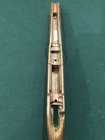Do you keep the pillars flush with the bottom of stock?
Yes.
What about the inside of the stock, pillars flush or slightly below the surface?
Roughly 1/16-1/8 inch below the surface, so that the epoxy bedding material covers the pillars and the rest of the action's bottom surface uniformly.
I also bed the recoil lug on the back (which everyone does), the front, and the sides, but I put 3-4 layers of painter's tape on the bottom of the lug to provide some clearance. I want the bedding to positively locate the action, just as a flat-bottomed action would be located. The bedding under the action (including the pillars) prevents the action from moving up and down (which is why some clearance under the recoil lug is provided). The bedding behind and in front of the recoil lug prevents the action from moving fore and aft. The bedding on the sides of the recoil lug prevents rotation of the (round) action due to the torque of firing.
I don't bed under the chamber area of the barrel, although some people do that for rifles where the barrel won't be changed often.
When people say "make my own pillars", are they machining their own? Or making them from 'other' parts?
A machinist friend of mine made me a pile of aluminum pillars for a few bucks. I've been using the same stash for 30 years, and still have plenty left.

I have some headless action screws I can use to guide the action into the stock, which sounds like the way to get it stress free, is this correct?
I use surgical tubing to hold the action in place while the epoxy cures. Electrical tape or masking tape will also work. I fold a piece of paper to the correct thickness to support the barrel at the tip of the forend, and to center it in the barrel channel.
Do you epoxy the pillars and bed at the same time or two different steps
Two steps. Glue in the pillars in Step 1, with space above the pillars for epoxy. The next day, bed the action in Step 2. When prepping the stock, be sure to leave a little stock material under the action at the "factory" height to properly locate the action. Remove enough material around the recoil lug to give a good depth of epoxy on all surfaces.
After the epoxy cures, drill out the pillars to 5/16" (for 1/4" action screws) so that the action screws don't touch the pillar.
I've always wanted to do a bedding job by myself, so maybe I'll still do this one.
Worst case (which has never happened to me) is that you have to grind out the bedding and re-do it.
Do use a relatively thick epoxy (JB Weld, Devcon 10110, MarineTex, etc.), which is much easier to handle than Acraglas. Don't use 5-minute epoxy -- you want the longer working time and higher strength of "regular" epoxy. Be generous with the release agent (I use Kiwi neutral shoe polish) and modeling clay (to fill any holes in the action where you don't want epoxy to go). Use masking tape and release agent to keep squeeze-out from getting on the stock. The more cleanup you do immediately after setting the action in the stock, the easier it will be -- acetone and Q-tips should be close at hand. Don't try to remove the action from the bedding until at least 24 hours has passed -- you want the epoxy to be fully cured. Impatience is a vice (DAMHIK).













